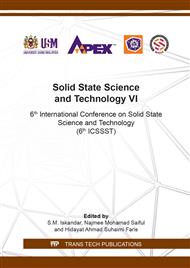[1]
Yan, L., A. Amirshaghaghi, D. Huang, J. Miller, J.M. Stein, T.M. Busch, Z. Cheng, and A. Tsourkas, Protoporphyrin IX (PpIX)‐Coated Superparamagnetic Iron Oxide Nanoparticle (SPION) Nanoclusters for Magnetic Resonance Imaging and Photodynamic Therapy. Advanced functional materials, 2018. 28(16): p.1707030.
DOI: 10.1002/adfm.201707030
Google Scholar
[2]
Liu, J., Y. Zhang, D. Chen, T. Yang, Z. Chen, S. Pan, and N. Gu, Facile synthesis of high-magnetization γ-Fe 2 O 3/alginate/silica microspheres for isolation of plasma DNA. Colloids and Surfaces A: Physicochemical and Engineering Aspects, 2009. 341(1): pp.33-39.
DOI: 10.1016/j.colsurfa.2009.03.033
Google Scholar
[3]
Urie, R., D. Ghosh, I. Ridha, and K. Rege, Inorganic Nanomaterials for Soft Tissue Repair and Regeneration. Annual review of biomedical engineering, 2018. 20: pp.353-374.
DOI: 10.1146/annurev-bioeng-071516-044457
Google Scholar
[4]
Kandasamy, G., A. Sudame, T. Luthra, K. Saini, and D. Maity, Functionalized hydrophilic superparamagnetic iron oxide nanoparticles for magnetic fluid hyperthermia application in liver cancer treatment. ACS Omega, 2018. 3(4): pp.3991-4005.
DOI: 10.1021/acsomega.8b00207
Google Scholar
[5]
Mary, A.R., T. Narayanan, V. Sunny, D. Sakthikumar, Y. Yoshida, P. Joy, and M. Anantharaman, Synthesis of Bio-Compatible SPION–based Aqueous Ferrofluids and Evaluation of RadioFrequency Power Loss for Magnetic Hyperthermia. Nanoscale research letters, 2010. 5(10): p.1706.
DOI: 10.1007/s11671-010-9729-4
Google Scholar
[6]
Rose, L.C., H. Suhaimi, M. Mamat, and T.Z. Lik. Synthesis and characterization of oleic acid surface modified magnetic iron oxide nanoparticles by using biocompatible w/o microemulsion for heavy metal removal. in AIP Conference Proceedings. 2017. AIP Publishing.
DOI: 10.1063/1.5002307
Google Scholar
[7]
Orsini, N.J., B. Babić-Stojić, V. Spasojević, M. Calatayud, N. Cvjetićanin, and G. Goya, Magnetic and power absorption measurements on iron oxide nanoparticles synthesized by thermal decomposition of Fe (acac) 3. Journal of Magnetism and Magnetic Materials, 2018. 449: pp.286-296.
DOI: 10.1016/j.jmmm.2017.10.053
Google Scholar
[8]
Arndt, D., V. Zielasek, W. Dreher, and M. Bäumer, Ethylene diamine-assisted synthesis of iron oxide nanoparticles in high-boiling polyolys. Journal of colloid and interface science, 2014. 417: pp.188-198.
DOI: 10.1016/j.jcis.2013.11.023
Google Scholar
[9]
Elfeky, S.A., S.E. Mahmoud, and A.F. Youssef, Applications of CTAB modified magnetic nanoparticles for removal of chromium (VI) from contaminated water. Journal of advanced research, 2017. 8(4): pp.435-443.
DOI: 10.1016/j.jare.2017.06.002
Google Scholar
[10]
Paul, K.G., T.B. Frigo, J.Y. Groman, and E.V. Groman, Synthesis of ultrasmall superparamagnetic iron oxides using reduced polysaccharides. Bioconjugate chemistry, 2004. 15(2): pp.394-401.
DOI: 10.1021/bc034194u
Google Scholar
[11]
Lee, H.S., E.H. Kim, H. Shao, and B.K. Kwak, Synthesis of SPIO-chitosan microspheres for MRI-detectable embolotherapy. Journal of Magnetism and Magnetic Materials, 2005. 293(1): pp.102-105.
DOI: 10.1016/j.jmmm.2005.01.049
Google Scholar
[12]
Lee, H.Y., N.H. Lim, J.A. Seo, G. Khang, J. Kim, H.B. Lee, and S.H. Cho, Preparation of poly (vinylpyrrolidone) coated iron oxide nanoparticles for contrast agent. Polymer Korea, 2005. 29(3): pp.266-270.
Google Scholar
[13]
Aziz, T., S.M. Masum, M.R. Qadir, A. Gafur, and D. Huq, Physicochemical Characterization of Iron Oxide Nanoparticle Coated with Chitosan for Biomedical Application. Int. Res. J. Pure Appl. Chem, 2016. 11: pp.1-9.
DOI: 10.9734/irjpac/2016/23408
Google Scholar
[14]
Silva, M.F., L.A. de Oliveira, M.A. Ciciliati, M.K. Lima, F.F. Ivashita, D.M. Fernandes de Oliveira, A.A.W. Hechenleitner, and E.A. Pineda, The Effects and Role of Polyvinylpyrrolidone on the Size and Phase Composition of Iron Oxide Nanoparticles Prepared by a Modified Sol-Gel Method. Journal of Nanomaterials, 2017. (2017).
DOI: 10.1155/2017/7939727
Google Scholar
[15]
De Sousa, M.E., M.B. Fernández van Raap, P.C. Rivas, P. Mendoza Zelis, P. Girardin, G.A. Pasquevich, J.L. Alessandrini, D. Muraca, and F.H. Sánchez, Stability and relaxation mechanisms of citric acid coated magnetite nanoparticles for magnetic hyperthermia. The Journal of Physical Chemistry C, 2013. 117(10): pp.5436-5445.
DOI: 10.1021/jp311556b
Google Scholar
[16]
Bee, A., R. Massart, and S. Neveu, Synthesis of very fine maghemite particles. Journal of Magnetism and Magnetic Materials, 1995. 149(1): pp.6-9.
DOI: 10.1016/0304-8853(95)00317-7
Google Scholar
[17]
Massart, R., Preparation of aqueous magnetic liquids in alkaline and acidic media. IEEE transactions on magnetics, 1981. 17(2): pp.1247-1248.
DOI: 10.1109/tmag.1981.1061188
Google Scholar
[18]
Itoh, H. and T. Sugimoto, Systematic control of size, shape, structure, and magnetic properties of uniform magnetite and maghemite particles. Journal of colloid and interface science, 2003. 265(2): pp.283-295.
DOI: 10.1016/s0021-9797(03)00511-3
Google Scholar
[19]
Zhang, Y., J.-Y. Liu, S. Ma, Y.-J. Zhang, X. Zhao, X.-D. Zhang, and Z.-D. Zhang, Synthesis of PVP-coated ultra-small Fe3O4 nanoparticles as a MRI contrast agent. Journal of Materials Science: Materials in Medicine, 2010. 21(4): pp.1205-1210.
DOI: 10.1007/s10856-009-3881-3
Google Scholar
[20]
Kale, A., S. Gubbala, and R. Misra, Magnetic behavior of nanocrystalline nickel ferrite synthesized by the reverse micelle technique. Journal of Magnetism and Magnetic Materials, 2004. 277(3): pp.350-358.
DOI: 10.1016/j.jmmm.2003.11.015
Google Scholar
[21]
Gnanaprakash, G., J. Philip, T. Jayakumar, and B. Raj, Effect of digestion time and alkali addition rate on physical properties of magnetite nanoparticles. The Journal of Physical Chemistry B, 2007. 111(28): pp.7978-7986.
DOI: 10.1021/jp071299b
Google Scholar
[22]
Sodipo, B.K. and A.A. Aziz, Recent advances in synthesis and surface modification of superparamagnetic iron oxide nanoparticles with silica. Journal of Magnetism and Magnetic Materials, 2016. 416: pp.275-291.
DOI: 10.1016/j.jmmm.2016.05.019
Google Scholar


